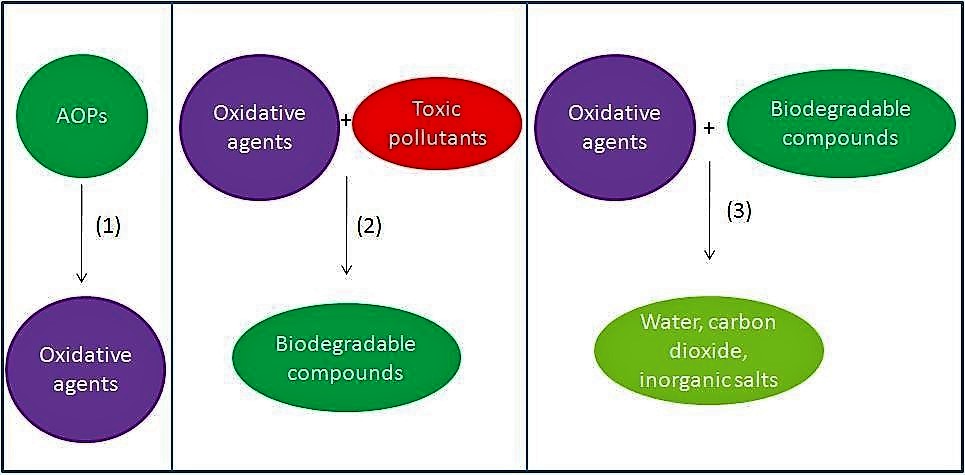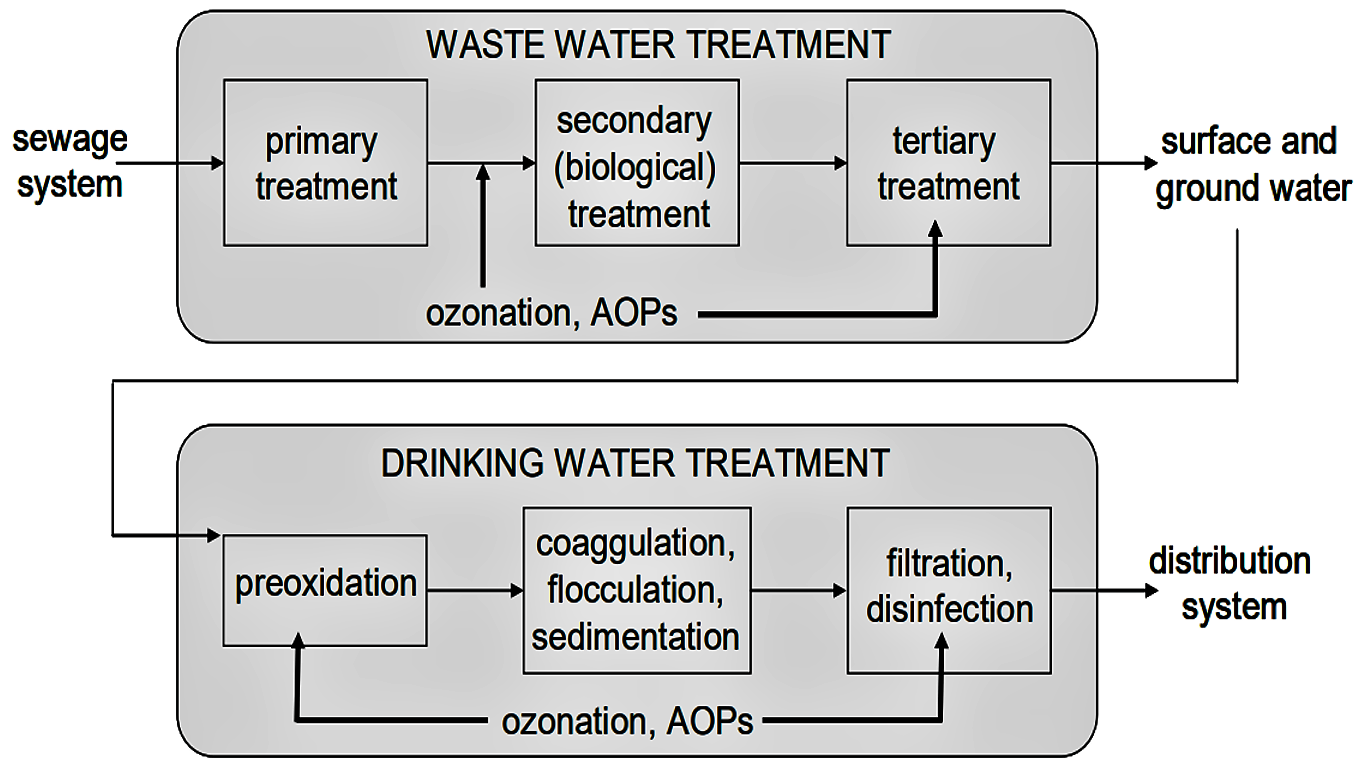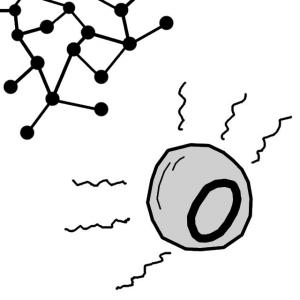Resumen ejecutivo
Hazardous organic waste, widely spread in water by industrial, military and domestic sources, is an emerging issue. Advanced Oxidation Processes (AOPs) are efficient methods to remove organic contamination not degradable by means of biological processes. AOPs are a set of processes involving the production of very reactive oxygen species able to destroy a wide range of organic compounds. AOPs are driven by external energy sources such as electric power, ultraviolet radiation (UV) or solar light, so these processes are often more expensive than conventional biological wastewater treatment. Moreover, AOPs can be applied for the disinfection of water, air and for remediation of contaminated soils.
| Entradas | Salidas |
|---|---|
Drinking Water, Blackwater, Greywater, Non-biodegradable Wastewater, Energy |
Drinking Water, Treated Water |
Introduction
Advanced Oxidation Processes (AOPs) refer to a set of oxidative water treatments that can be used to treat toxic effluents at industrial level, hospitals and wastewater treatment plants. AOPs are successful to transform toxic organic compounds (e.g. drugs, pesticides, endocrine disruptors etc.) into biodegradable substances. AOPs in general are cheap to install but involve high operating costs due to the input of chemicals and energy required (COMINELIS et al. 2008). To limit the costs, AOPs are often used as pre-treatment combined with biologic treatment (PULGARIN et al. 1999). Advanced oxidation was recently also used as quaternary treatment or a polishing step to remove micro-pollutants from the effluents of municipal wastewater treatment plants and for the disinfection of water. The combination of several AOPs is an efficient way to increase pollutant removal and reduce costs.
Examples of AOPs
Many methods are classified under the broad definition of AOPs. The table shows some of the most studied processes. Advanced oxidation generally uses strong oxidising agents like hydrogen peroxide (H2O2) or ozone (O3), catalysts (iron ions, electrodes, metal oxides) and irradiation (UV light, solar light, ultrasounds) separately or in combination under mild conditions (low temperature and pressure). Among different available AOPs, those driven by light seem to be the most popular technologies for wastewater treatment as shown by the large amount of data available in the literature (STASINAKIS 2008). Solar AOPs are particularly attractive due to the abundance of solar light in regions where water scarcity is high and due to their relatively low costs and high efficiencies.
Dark AOP | Light driven AOP |
| Ozone (O3) Fenton (Fe2+ + H2O2) Electrolysis (electrodes + current) Sonolysis (Ultrasounds) | Photolysis (UV + H2O2) Photocatalysis (light + catalyst) |
Examples of methods classified as AOPs. Source: STASINAKIS (2008)
AOP mechanism
Advanced oxidation involves several steps schematised in the figure below and explained as follows:
- Formation of strong oxidants (e.g. hydroxyl radicals).
- Reaction of these oxidants with organic compounds in the water (KOMMINENI et al. 2008) producing biodegradable intermediates.
- Reaction of biodegradable intermediates with oxidants referred to as mineralisation (i.e. production of water, carbon dioxide and inorganic salts).

Strategies to implement AOPs
(Adapted from COMNINELLIS et al. 2008)
The costs of AOPs are relatively high and directly related to the efficiency and operational time of the processes. It is therefore worth optimising implementation of AOPs at the right place to limit costs. Several strategies were found to achieve this:
- Simultaneous application of different AOPs promotes the rates of organics oxidation. Typical examples include UV/H2O2, UV/H2O2/TiO2, UV/Fenton and Ultrasound/UV/TiO2, among others. These types of combinations may lead to synergetic effects when treatment efficiencies are greater than the sum of efficiencies that could be achieved by the individual treatments alone.
- Sequential application of various AOPs can treat effluents containing a mixture of organics. This approach is useful when the compounds in the mixture present different levels of reactivity towards different AOPs.
- Application of separation treatment prior to AOP treatment to transfer pollutants to another phase so that they can be treated more easily. Such separation treatment includes stripping, coagulation-flocculation, sedimentation, filtration, adsorption etc.
- AOPs can be applied in pre-treatment stage to enhance biodegradability and to reduce toxicity followed by biological post-treatment. This approach is based on the fact that biological treatment is perhaps less costly and more environmentally friendly than other destructive treatments and that complete mineralisation by AOPs incurs excessive treatment costs.

AOPs can be installed at different stages of waste (and also drinking) water treatment plants depending on influent composition and desired effluent quality. AOPs can be installed either as tertiary treatment after the biological (secondary) treatment of wastewater, or as pre-treatment stage in order to enhance the biodegradability of trace organic contaminants (PETROVIC et al. 2011).
At a glance
| Working principle | Production of reactive oxygen species able to destroy toxic compounds and biologic contamination in water. |
| Capacity/adequacy | High-tech equipment required. |
| Performance | High efficiency except for few chemicals |
| Costs | High operation costs |
| Self-help compatibility | Engineers are required for the design |
| O&M | Generally continuous supply of chemicals (ozone, H2O2…) required |
| Reliability | Reliable if operating conditions are scaled taking into account wastewater content |
| Main strength | Destroys almost all organics without pollution transfer to another phase |
| Main weakness | Operation costs |
AOPs have a wide range of applications such as air (odour elimination, purification), soil (remediation) and water decontamination. In water, these processes have the ability to destroy organic pollutants but they can also be adapted to the removal of inorganic metals. Furthermore AOPs are successful to inactivate bacteria, viruses etc. Different kinds of water are therefore suitable for an AOP treatment: for example industrial wastewater containing toxic compounds can be treated by solar photo-Fenton; surface or ground water can be disinfected by means of improved solar water disinfection by adding H2O2 (see also H2O2 and SODIS); both bacteria in drinking water plants or micro-pollutants in sewage systems can be degraded using ozonation; Dissolved arsenic can be removed from water by co-precipitation by means of simple methods (GENORI et al. 2009) in presence of iron (see also arsenic removal technologies).
Perspective Advanced Oxidation Processes for Water Treatment: Advanced and Trends for R&D
Removal of Arsenic (III) from Contaminated Waters using Iron (II) and Citrate
Advanced Oxidation Processes
Advanced oxidation processes (AOPs) applied for wastewater and drinking water treatment. Elimination of pharmaceuticals
Strategy for the coupling of photochemical and biological flows reactors useful in mineralization of biorecalcitrant industrial pollutants
Use of Selected Advanced Oxidation Processes (AOPs) for Wastewater Treatment- A Mini Review
Treatment of Textile Wastewater by Advanced Oxidation Processes – A Review
This review article focuses on the treatment of textile wastewaters by means of different AOPs.
ADEL, A. K. ; AZNI, I. ; KATAYON, S. ; CHUAH, T.G. (2004): Treatment of Textile Wastewater by Advanced Oxidation Processes – A Review. Entradas: Global Nest: the International Journal – General Information: Volume 6 , 222-230. URL [Visita: 21.05.2019]Comparison of Different Advanced Oxidation Processes for Treatment of Antibiotic Aqueous Solution
This study compares the treatment of antibiotic aqueous solutions by different light assisted AOPs from a technical and economic point of view.
ELMOLLA E. S. ; CHAUDHURI, M. (2010): Comparison of Different Advanced Oxidation Processes for Treatment of Antibiotic Aqueous Solution . Entradas: Desalination: Volume 256 , 43-47. URL [Visita: 08.09.2011]Advanced Oxidation Processes and UV Photolysis for Treatment of Drinking Water
This document describes an investigation where the combination of UV light and ozone is used to degrade micro-pollutants in drinking water.
MOFIDI, A. A. ; MIN, J. H. ; PALENCIA, L.S. ; COFFEY, B. M. ; GREEN, J. F. (2002): Advanced Oxidation Processes and UV Photolysis for Treatment of Drinking Water. Entradas: California Energy Commission: URL [Visita: 07.09.2011]Advanced Oxidation Processes and their Application in the Petroleum Industry: A review
This paper describes a series of AOPs, analysing the aspects related to each type of process, such as the interference of external agents and the ideal operating conditions, based on the analysis and comparison of different studies in the area. In addition, several applied AOP studies on treatment of oil wastewater and on remediation of soil contaminated with oil or its derivatives are presented.
MOTA, A. L. N. ; ALBUQUERQUE, L.F. ; BELTRAME, L.T.C. ; CHIAVONE-FILHO, A. ; MACHULEK JR., A. ; NASCIMENTO, C.A.O. (2008): Advanced Oxidation Processes and their Application in the Petroleum Industry: A review. Entradas: Brazilian Journal of Petroleum and Gas: Volume 2 , 122-142. URL [Visita: 08.09.2011]Advanced Oxidation Processes – Current Status and Prospects
The paper provides an overview of theoretical basis, efficiency, economics, laboratory and pilot plant testing; design and modelling of different advanced oxidation processes (combinations of ozone and hydrogen peroxide with UV radiation and catalysts).
MUNTEN, R. (2001): Advanced Oxidation Processes – Current Status and Prospects. Entradas: Proceedings of the Estonian Academy of Science. Chemistry 50: , 58-80. URL [Visita: 07.09.2011]Advanced Treatment by Ozonation and Sonolysis for Domestic Wastewater Reuse
This publication describes the combination of ozone and ultrasounds for the disinfection and discoloration of domestic wastewater treatment plant effluents for reuse purposes.
SELCUK, H. ; NADDEO, V. ; BELGIONO, V. (2007): Advanced Treatment by Ozonation and Sonolysis for Domestic Wastewater Reuse. Entradas: Proceedings of the 10th International Conference on Environmental Science and Technology: URL [Visita: 21.05.2019]An Overview of the Integration of Advanced Oxidation Technologies and Other Processes for Water and Wastewater Treatment
In this review, recent achievements, developments and trends (2003-2009) on the integration of advanced oxidation technologies and other remediation methods are presented. Selecting the right AOP is discussed taking into account the characteristics of the waste stream, environmental regulations, and cost.
MOHAJERANI, M. ; MEHRVAR, M. ; EIN-MOZAFFARI, F.E. (2009): An Overview of the Integration of Advanced Oxidation Technologies and Other Processes for Water and Wastewater Treatment. Entradas: International Journal of environmental engineering: Volume 3 , 120-146. URL [Visita: 21.05.2019]Treatment of Textile Wastewater by Advanced Oxidation Processes – A Review
This review article focuses on the treatment of textile wastewaters by means of different AOPs.
ADEL, A. K. ; AZNI, I. ; KATAYON, S. ; CHUAH, T.G. (2004): Treatment of Textile Wastewater by Advanced Oxidation Processes – A Review. Entradas: Global Nest: the International Journal – General Information: Volume 6 , 222-230. URL [Visita: 21.05.2019]Waste Water Treatment by Advanced Oxidation Processes (Solar Photocatalysis in Degradation of Industrial Contaminants)
Saline industrial wastewater containing non-biodegradable compounds (a-methylphenylglycine) can be treated by a photo-Fenton process. However, in order to reduce the treatment costs, the AOP can be coupled with a biologic treatment as soon as water is biodegradable.
MALATO, S. (2007): Waste Water Treatment by Advanced Oxidation Processes (Solar Photocatalysis in Degradation of Industrial Contaminants). Plataforma Solar de Almeria-CIEMAT. [Acccessed: 20.07.2011] PDFTraitement des Micropolluants dans les Eaux Uses-Rapport Final sur les Essais Pilotes a la STEP de Vidy (Lausanne)
This document presents the results of a pilot study aiming at removing water micropollutants at the Lausanne (Switzerland) wastewater treatment plant.
MARGOT, J. ; MAGNET, A. ; THONNEY, D. ; CHEVRE, N. ; ALENCASTRO, F. de ; ROSSI, L. (2011): Traitement des Micropolluants dans les Eaux Uses-Rapport Final sur les Essais Pilotes a la STEP de Vidy (Lausanne). Entradas: Ed. Ville de Lausanne : URL [Visita: 21.05.2019]Handbook of Advanced Photochemical Oxidation Processes
This handbook summarises commercial-scale system performance and cost data for advanced photochemical oxidation treatment of contaminated water, air and solids.
EPA (1998): Handbook of Advanced Photochemical Oxidation Processes. United States Environmental Protection Agency (EPA). [Accessed: 07.09.2011]Use of Advanced Oxidation Processes to Improve the Biodegradability of Landfill Leachates
Presentation on landfill leachate treatment by coupled biological and electrochemical processes.
HULLEBUSCH E.D. van ; OTURAN, M.A. (2011): Use of Advanced Oxidation Processes to Improve the Biodegradability of Landfill Leachates. Entradas: Summer School: Biological and Thermal Treatment of Municipal Solid Waste, Napoli: URL [Visita: 08.09.2011]Photocatalysis for Water Treatment
This document outlines the social and economical relevance of photocatalysis, provides background information on the technology, and highlights further challenges to be addressed.
MULLER, N. ; NOWACK, B. ; OY, S. ; SAARI, J. (2010): Photocatalysis for Water Treatment. Entradas: ObservatoryNANO Briefings: URL [Visita: 21.05.2019]Advanced Oxidation Processes
This website gives an overview of applicability, limitations and costs of UV oxidation.


